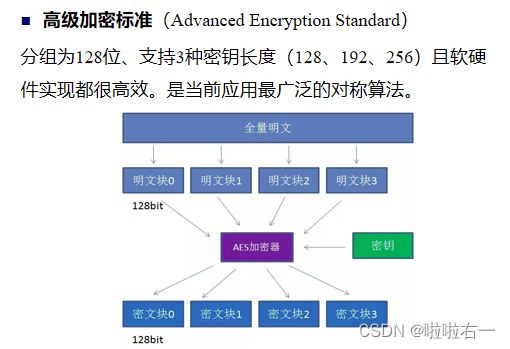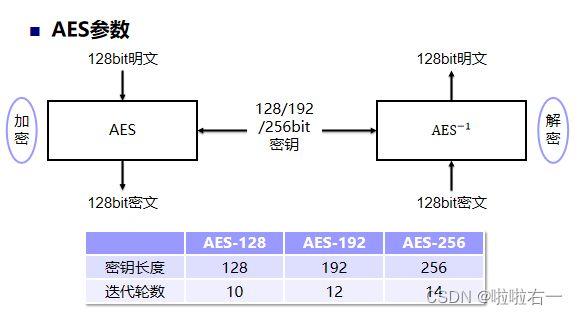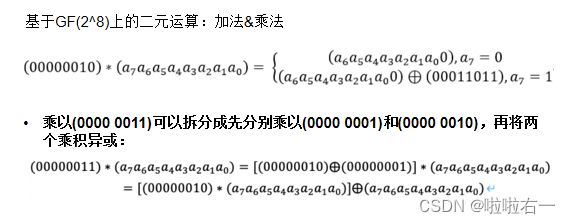大数据安全 | 【实验】S-AES加密
文章目录
- 关于AES
- 实验目的
- 流程梳理
-
- Step1:密钥扩展算法
-
- 8位的异或
- 字节替换
- g函数
- Step2:第0轮
-
- 轮密钥加
- Step3:第一轮
-
- 行变换
- 列混淆
- Step4:第二轮
- 实验结果
关于AES
实验目的
- 实现 S-AES加密。
- 测试数据:使用密钥 1010 0111 0011 1011 加密二进制明文 0110 1111 0110 1011,得出二进制密文 0000 0111 0011 1000。
流程梳理
- S-AES 是 AES 加解密方法的缩减版。AES 的明文包括 128 位、256 位等处理,而 S-AES 只是对 16 位二进制明文进行处理;
- AES 需要进行 0+10 轮加密,而S-AES 只进行 0+2 轮加密
- 第0轮只进行
轮密钥加- 第一轮进行
字节替换、行变换、列混淆和轮密钥加- 第二轮只进行
字节替换、行变换和轮密钥加
Step1:密钥扩展算法
-
密钥的左半部分:
key1[0] = OR_8(key[0], g(key[1], rcon1));- g函数:
g(key[1], rcon1)- 将第i-1个密钥的右半部分(8位)进行左循环移位,即将第i-1个密钥的右半部分的左右4位进行交换
- 再将左循环移位后的第i-1个密钥的右半部分(8位)进行字节替换
- 进行字节替换后需要与轮常数进行异或
OR_8(key[0], g(key[1], rcon1))- 将第i-1个密钥的右半部分(8位)执行完g函数后得到
g(第i-1个密钥的右半部分) - 将其与第i-1个密钥的左半部分(8位)进行异或得到第
i个密钥的左半部分。
- 将第i-1个密钥的右半部分(8位)执行完g函数后得到
- g函数:
-
密钥的右半部分:
key1[1] = OR_8(key1[0], key[1]);。第i个密钥的右半部分由第i个密钥的左半部分与第i-1个密钥的右半部分进行异或得到。//密钥扩展算法,需要扩展出两个密钥key1和key2 int **key1 = new int *[2]; for (int i = 0; i < 2; i++) key1[i] = new int[8]; int **key2 = new int *[2]; for (int i = 0; i < 2; i++) key2[i] = new int[8]; //key1生成 key1[0] = OR_8(key[0], g(key[1], rcon1)); key1[1] = OR_8(key1[0], key[1]); //key2生成 key2[0] = OR_8(key1[0], g(key1[1], rcon2)); key2[1] = OR_8(key2[0], key1[1]);
8位的异或
- 对两个8位数组进行异或操作(4位异或也是同理)。
//8位的异或 int *OR_8(int *a, int *b) { int *result = new int[8]; for (int i = 0; i < 8; i++) result[i] = a[i] ^ b[i]; return result; }
字节替换
-
具体而言,对 16 位二进制明文,8 位一组,每组中包含两个 16 进制的二进制表达,也就是 4 位为一个单位进行字节替代。前两位求其十进制得到行号,后两位求其十进制得到列号。
-
然后到 S 盒中找到替换的那几组数据替换上,每次调用函数替换一组,共换 4 个单位的数据。
//字节替换 void SubBytes(int *temp) { //将8位二进制分组为4个2位的数字,这里的×2使得t的范围为0~3,可在表中对应位置检索 int t1 = 2 * temp[0] + temp[1]; int t2 = 2 * temp[2] + temp[3]; int t3 = 2 * temp[4] + temp[5]; int t4 = 2 * temp[6] + temp[7]; //在S盒中找到替换后的值 int num1 = s[t1][t2]; int num2 = s[t3][t4]; //分别进行四位四位的替换 for (int i = 0; i < 4; i++) temp[i] = Replace[num1][i]; for (int i = 0; i < 4; i++) temp[i + 4] = Replace[num2][i]; }
g函数
- 将第i-1个密钥的右半部分(8位)进行左循环移位,即将第i-1个密钥的右半部分的左右4位进行交换
- 再将左循环移位后的第i-1个密钥的右半部分(8位)进行字节替换
- 进行字节替换后需要与轮常数进行异或
//g函数 int *g(int *temp, int *rcon) { //这个temp是密钥的右半部分,不能改动,要复制一个新的进行计算 int *t = new int[8]; for (int i = 0; i < 8; i++) t[i] = temp[i]; //循环左移,即左右4位进行交换 for (int i = 0; i < 4; i++) { int tt = t[i + 4]; t[i + 4] = t[i]; t[i] = tt; } //移位后的右半部分进行字节替换 SubBytes(t); //与轮常数异或 return OR_8(t, rcon); }
Step2:第0轮
- 只进行
轮密钥加,即AddRoundKey(plaintext, key);
轮密钥加
-
轮密钥加就是每组与密钥的每组分别异或。
-
第0轮中使用的是初始密钥
-
第一轮用到的是密钥拓展后的第一个 8 位密钥,即key1
-
第二轮用到的是密钥拓展后的第二个 8 位密钥,即key2
//轮秘钥加 void AddRoundKey(int **mingwen, int **key) { for (int i = 0; i < 2; i++) for (int j = 0; j < 8; j++) mingwen[i][j] ^= key[i][j]; }
Step3:第一轮
- 第一轮进行
字节替换、行变换、列混淆和轮密钥加// 第一轮 // 明文半字节代替 SubBytes(plaintext[0]); SubBytes(plaintext[1]); // 明文的行变换 ShiftRows(plaintext); // 明文的列混淆 MixColumns(plaintext); // 明文的轮密钥加 AddRoundKey(plaintext, key1);
行变换
关注60是一个字节,4C是一个字节!所以从咱们数组上看,就是第一字节的右半部分和第二字节的右半部分进行替换。
//行变换
void ShiftRows(int **temp)
{
//第一字节的右半部分和第二字节的右半部分进行替换
for(int i = 4;i < 8;i ++)
{
int t = temp[0][i];
temp[0][i] = temp[1][i];
temp[1][i] = t;
}
}
列混淆
【AES加密算法】| AES加密过程详解】16分07秒
-
列混淆本质上就是乘上一个矩阵,运算定义在 G F ( 2 4 ) GF(2^4) GF(24),所以乘上矩阵[[1,4],[4,1]],于是我们可以得出运算公式:

-
其中 S 0 , 0 S_{0,0} S0,0 和 S 1 , 0 S_{1,0} S1,0是一个字节,各为4位。 S 0 , 1 S_{0,1} S0,1 和 S 1 , 1 S_{1,1} S1,1是一个字节,各为4位。得到:

-
“加”实际上是异或。
-
x_fx函数用于计算 x*f(x),即将多项式 f(x) 进行左移,并根据最高次数是否为 1 进行取模操作(原理类似下图)。

-
multiply函数用于进行多项式乘法操作,在有限域 GF(2^8) 上进行。- 乘法 a(x)*b(x)可以拆成多个 a(x)*x^n 的异或操作。
- 首先根据输入多项式 a,使用
x_fx函数计算 a ∗ ( x 1 ) a*(x^1) a∗(x1)、 a ∗ ( x 2 ) a*(x^2) a∗(x2) 和 a ∗ ( x 3 ) a*(x^3) a∗(x3) 分别得到 x1fx、x2fx 和 x3fx。 - 根据输入多项式 b 的系数,分别使用异或操作符对 x3fx、x2fx、x1fx 和 a 进行运算,得到结果数组 result。
-
MixColumns函数用于进行列混淆操作,输入为明文矩阵 mingwen。 -
最终得到经过列混淆操作后的明文矩阵。
//实现x*f(x)的函数 void x_fx(int last[4], int res[4]) { //res是结果,last是上一步的结果 if (last[0] == 0) { //最高次为0 for (int i = 0; i < 3; i++) //低三项分别升幂次 res[i] = last[i + 1]; } else { //最高次为1 res[1] = last[2]; res[2] = last[3] == 1 ? 0 : 1; res[3] = 1; } } //乘法 int *multiply(int a[4], int b[4]) { //储存结果的系数 int *result = new int[4]; for (int i = 0; i < 4; i++) result[i] = 0; //记录下a*(x^n) int x1fx[4] = {0}; x_fx(a, x1fx);//a*(x^1)=a*{0,0,1,0}=a*b3 int x2fx[4] = {0}; x_fx(x1fx, x2fx);//a*(x^2)=a*{0,1,0,0}=a*b2 int x3fx[4] = {0}; x_fx(x2fx, x3fx);//a*(x^3)=a*{1,0,0,0}=a*b1 //现在需要根据多项式a和b开始异或 if (b[0] == 1)//b1=={1,0,0,0} for (int i = 0; i < 4; i++) result[i] ^= x3fx[i]; if (b[1] == 1)//b2=={0,1,0,0} for (int i = 0; i < 4; i++) result[i] ^= x2fx[i]; if (b[2] == 1)//b3=={0,0,1,0} for (int i = 0; i < 4; i++) result[i] ^= x1fx[i]; if (b[3] == 1)//b4=={0,0,0,1} for (int i = 0; i < 4; i++) result[i] ^= a[i]; return result; } //列混淆 void MixColumns(int **mingwen) { int rule[4] = {0, 1, 0, 0}; int *m00 = new int[4]; // 第一行的前4个元素 int *m10 = new int[4]; // 第一行的后4个元素 int *m01 = new int[4]; // 第二行的前4个元素 int *m11 = new int[4]; // 第二行的后4个元素 for (int i = 0; i < 4; i++) { m00[i] = mingwen[0][i]; m10[i] = mingwen[0][i + 4]; m01[i] = mingwen[1][i]; m11[i] = mingwen[1][i + 4]; } int *n00 = new int[4]; int *n10 = new int[4]; int *n01 = new int[4]; int *n11 = new int[4]; n00 = OR_4(m00, multiply(rule, m10)); n10 = OR_4(multiply(rule, m00), m10); n01 = OR_4(m01, multiply(rule, m11)); n11 = OR_4(multiply(rule, m01), m11); for (int i = 0; i < 4; i++) { mingwen[0][i] = n00[i]; mingwen[0][i + 4] = n10[i]; mingwen[1][i] = n01[i]; mingwen[1][i + 4] = n11[i]; } }
Step4:第二轮
-
第二轮只进行
字节替换、行变换和轮密钥加// 第二轮 // 明文半字节代替 SubBytes(plaintext[0]); SubBytes(plaintext[1]); // 明文的行移位 ShiftRows(plaintext); // 明文的轮密钥加 AddRoundKey(plaintext, key2);
实验结果
#include 代码学习来源:S-AES加密实现
- 以上若有理解错的地方欢迎指正!
- 针对列混淆的细节理解,欢迎评论区补充(✪ω✪)!









